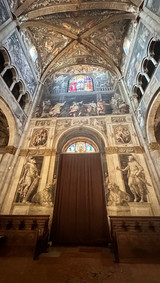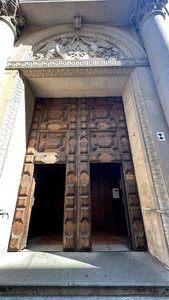Parma Churches – Chiese di Parma
- Maria Scuor
- Sep 26, 2024
- 9 min read
Italiano sotto ogni sezione
There is something about the churches in Italy that I can’t go by then without visiting them. Maybe it’s the architecture, maybe it’s the history, maybe it’s the art, or maybe it’s feeling closer to my mom when I’m in them. Remembering the way, she would be the same way when we were visiting Italy, when I was a child. Whatever reason it is, I know I love kneeling at every altar and connecting with my faith and praying. Spiritual wellness is so important and I’m so thankful I have found it again, here in Italy.
Parma Cathedral and Baptistery – Duomo e Battisterio di Parma
It looks like a basilica (Mother Church) existed in the churchyard of the present-day cathedral that dates back between the 4th and 6th century. Then around the 9th century, Bishop-Count Guibodo built another Mother Church and had it consecrated dedicated to the Virgin Mary, Mother of God in 890 and it was named Domus, the start of the current name Duomo.
When a devastating fire destroyed the basilica, Bishop Cadalo broke ground for a new cathedral in 1058 and in 1074. The cathedral was built in Piazza Vecchia or platea ecclesiae maioris, now Piazza Duomo and consecrated by Pope Paschal II in 1106. Due to an earthquake in 1117, the cathedral was heavily damaged and required much restoration.
Since then, the important Romanesque cathedral has been a symbol of the city’s living religious history full of priceless Romanesque sculptures, Renaissance paintings and priceless treasures, especially the dome which was frescoed by Renaissance painter Antonio da Correggio.
The façade is made from blocks of sandstone and has three loggia floors and three portals. The Gothic belfry (tower), topped by a copper angel, was adding between 1284-1294. Beside the cathedral is the Baptistery of Parma.
The interior has a Latin cross plan, with a nave and two aisles. Both the presbytery and transept are elevated which gives space to the underlaying crypt. In the 16th century the red Verona marble staircase that leads to the transepts was added. Side chapels were added to house rooms or sepulchers of the noble families in Parma.
Baptistery - Battisterio
The Baptistery, is a mix between Romanesque and Gothic styles and is considered one of the most important Medieval monuments in Europe. It was built in 1196 by Benedetto Antelami and it was important to the council of Parma that the citizens be attached to this project, therefore men put stones in the foundation to commemorate their families. It is dedicated to St. John the Baptist.
The exterior is octagonal with four tiers of open loggias and is made of pink Verona Marble. Eight turrets crown the top of the building and the lowest part is encircled with bas-relief sculptures of animals, beasts, sea monsters, centaurs, mermaids and unicorns. The “Portal of the Virgin” overlooks the Piazza del Duomo and named after the Virgin and Child. The figure is in the lunette above the entrance.
The Baptistery was closed when we were there but inside it there is the stunning painted domed ceiling which the vault is divided into six concentric horizontal bands. Each has a different series of frescoes painted on them. The red circle represents upper heaven. The altar is in marble and has a semi-dome over it. The large, octagonal baptismal basin stands in the middle and is made of Verona marble and is designed for baptism by immersion. A baptismal font that is used for baptism by affusion (pouring water over the head) was built in the 14th century.
Here is a TikTok video and photos of the cathedral and baptistery - Ecco un video TikTok e le foto della cattedrale e del battistero
Exterior - Esterno
Interior - Interno
Photos of the baptistery are from Piazza Duomo Parma website - Le foto del battistero sono tratte dal sito di Piazza Duomo Parma
C'è qualcosa nelle chiese in Italia che non posso assolutamente visitare senza visitarle. Forse è l'architettura, forse è la storia, forse è l'arte, o forse è il sentirsi più vicini a mia madre quando ci sono dentro. Ricordando il cammino, lei sarebbe stata la stessa quando visitavamo l'Italia, quando ero bambina. Qualunque sia la ragione, so che amo inginocchiarmi davanti a ogni altare e connettermi con la mia fede e pregare. Il benessere spirituale è così importante e sono così grata di averlo ritrovato, qui in Italia.
Duomo e Battisterio di Parma
Sembra che nel sagrato dell'attuale cattedrale esistesse una basilica (Chiesa Madre) che risale tra il IV e il VI secolo. Poi, intorno al IX secolo, il vescovo-conte Guibodo fece costruire un'altra Chiesa Madre e la fece consacrare dedicata alla Vergine Maria, Madre di Dio nell'890 e prese il nome di Domus, da cui l'inizio dell'attuale nome Duomo.
Quando un devastante incendio distrusse la basilica, il vescovo Cadalo diede il via alla costruzione di una nuova cattedrale nel 1058 e nel 1074. La cattedrale fu costruita in Piazza Vecchia o platea ecclesiae maioris, oggi Piazza Duomo e consacrata da Papa Pasquale II nel 1106. A causa di un terremoto nel 1117, la cattedrale fu pesantemente danneggiata e richiese molti restauri.
Da allora, l'importante cattedrale romanica è stata un simbolo della storia religiosa viva della città ricca di sculture romaniche di inestimabile valore, dipinti rinascimentali e tesori inestimabili, in particolare la cupola che è stata affrescata dal pittore rinascimentale Antonio da Correggio.
La facciata è realizzata in blocchi di arenaria e presenta tre piani di logge e tre portali. La torre campanaria gotica, sormontata da un angelo in rame, fu aggiunta tra il 1284 e il 1294. Accanto alla cattedrale si trova il Battistero di Parma.
L'interno è a croce latina, a tre navate. Sia il presbiterio che il transetto sono rialzati, il che dà spazio alla cripta sottostante. Nel XVI secolo fu aggiunta la scala in marmo rosso di Verona che conduce ai transetti. Cappelle laterali furono aggiunte alle stanze delle case o ai sepolcri delle famiglie nobili di Parma.
Battisterio
Il Battistero, è un mix tra lo stile romanico e quello gotico ed è considerato uno dei monumenti medievali più importanti d'Europa. Fu costruita nel 1196 da Benedetto Antelami e per il comune di Parma era importante che i cittadini fossero legati a questo progetto, quindi gli uomini misero delle pietre nelle fondamenta per commemorare le loro famiglie. È dedicata a San Giovanni Battista.
L'esterno è ottagonale con quattro ordini di logge aperte ed è realizzato in marmo rosa di Verona. Otto torrette coronano la parte superiore dell'edificio e la parte più bassa è circondata da sculture in bassorilievo di animali, bestie, mostri marini, centauri, sirene e unicorni. Il "Portale della Vergine" si affaccia su Piazza del Duomo ed è intitolato alla Vergine con il Bambino. La figura si trova nella lunetta sopra l'ingresso.
Il Battistero era chiuso quando ci siamo stati noi ma al suo interno c'è lo splendido soffitto a cupola dipinta la cui volta è divisa in sei fasce orizzontali concentriche. Ognuno ha una diversa serie di affreschi dipinti su di esso. Il cerchio rosso rappresenta il cielo superiore. L'altare è in marmo e sovrasta una semicupola. Al centro si trova il grande bacino battesimale ottagonale, realizzato in marmo di Verona ed è pensato per il battesimo per immersione. Un fonte battesimale che viene utilizzato per il battesimo per affusione (versando acqua sulla testa) è stato costruito nel XIV secolo.
Basilica of Santa Maria della Steccata – Basilica di Santa Maria della Steccata
An oratory that dated back to 1392 housed a venerated image of John the Baptist. Towards the 14th century a painting of a breastfeeding Madonna was painted on the façade of the oratory, which didn’t take long to become the devotion of the people of Parma.
To protect the painting and perhaps regulate the influx of numerous pilgrims, a picket fence was built around it. Therefore, the Virgin became to be known as Santa Maria della Steccata (picket fence). In 1521, the congregation decided to built a grandiose sanctuary to protect the painting and Bishop Nicolò Urbani of Lodi laid the first stone. Like most church buildings in Italy, it took until February 24, 1539 for the church to be consecrated by Cardinal Gian Maria Ciocchi del Monte.
The basilica is in Baroque style architecture with an ornate dome and façade decorated with sculptures and carvings, including the Madonna holding an infant Jesus and surrounded by angels and cherubs.
The interior is set on a Greek Cross plan which has four large symmetrical apses and between the arms four chapels. The marble floors, frescos, altars and the majestic dome are very impressive. The walls have beautiful frescoes, including those by the Fianese brothers. The crypt, located under the main altar, contains the remains of many of the Duke of Parma’s family members.
The current pipe organ was built in 1892 to replace one that was built in 1574. Placed above a gallery specially erected in the apse it was restored in 1940, then again in 1970 which expanded the organ and, joining it to the old one and equipped it with a new console. It now has an electronic transmission, four keyboards of 61 notes and a pedal board of 32.
In the area of the Virgin Mary there are many PGR (For Grace Received) hearts.
Exterior - Esterno
Interior - Interno
PGR Area - Zona PGR
Basilica di Santa Maria della Steccata
Un oratorio che risaliva al 1392 ospitava una venerata immagine di Giovanni Battista. Verso il XIV secolo sulla facciata dell'oratorio fu dipinta una tela raffigurante una Madonna che allatta al seno, che non tardò a diventare la devozione del popolo parmense.
Per proteggere il dipinto e forse regolare l'afflusso di numerosi pellegrini, fu costruita una staccionata intorno ad esso. Per questo motivo, la Vergine divenne nota come Santa Maria della Steccata. Nel 1521 la congregazione decise di costruire un grandioso santuario per proteggere il dipinto e il vescovo Nicolò Urbani di Lodi pose la prima pietra. Come la maggior parte degli edifici ecclesiastici in Italia, ci volle fino al 24 febbraio 1539 perché la chiesa fosse consacrata dal cardinale Gian Maria Ciocchi del Monte.
La basilica è in stile barocco con una cupola decorata e una facciata decorata con sculture e intagli, tra cui la Madonna che tiene in braccio un bambino Gesù e circondata da angeli e cherubini.
L'interno è impostato su una pianta a croce greca che presenta quattro grandi absidi simmetriche e tra i bracci quattro cappelle. I pavimenti in marmo, gli affreschi, gli altari e la maestosa cupola sono molto suggestivi. Le pareti presentano bellissimi affreschi, tra cui quelli dei fratelli fianese. La cripta, situata sotto l'altare maggiore, custodisce le spoglie di molti membri della famiglia del Duca di Parma.
L'attuale organo a canne fu costruito nel 1892 per sostituire quello costruito nel 1574. Posto sopra un ballatoio appositamente eretto nell'abside, fu restaurato nel 1940, poi di nuovo nel 1970 che ampliò l'organo e, unendolo a quello vecchio, lo dotò di una nuova consolle. Ora ha una trasmissione elettronica, quattro tastiere da 61 note e una pedaliera da 32.
Nella zona della Vergine Maria ci sono molti cuori PGR (Per la Grazia Ricevuta).
Church of Santa Cristina – Chiesa di Santa Cristina
Santa Cristina church is a Baroque style catholic place of worship that dates back to the 10th century. It was entrusted by the Duchess Margherita Aldobrandini in 1629 to the order of the Theatine Clerics Regular who governed it until 1805. The Theatine Fathers completely rebuilt the church and the adjacent monastery starting in 1649 and it was completed in 1662.
Due to lack of funds the façade remained unfinished and the apse area wasn’t built. The building has three naves, divided by pillars and capitals, with four chapels on each side, in front of each is a small hemispherical dome. There are frescos that decorate the entire church painted by Filippo Maria Galletti between 1636 – 1714.
The altar is made of gilded wood and painted to resemble marble. The altarpiece is of Saint Cristina with her body pieced by arrows and angels carrying her soul to heaven. The choir loft was added to the central door in 1720 and organ built in 1762. It was damaged in the bombings of 1944 and restored in 1983 with mechanical transmission, a single keyboard with first octave scavezza and a scavezza music stand pedalboard.
In front of the Mother and Child painting there is an area with notes of PGR (For Grace Received). Nothing like the ones we saw in the sanctuaries but still heartwarming to say the least.
PGR Area - Zona PGR
Chiesa di Santa Cristina
La chiesa di Santa Cristina è un luogo di culto cattolico in stile barocco che risale al X secolo. Fu affidata dalla duchessa Margherita Aldobrandini nel 1629 all'ordine dei Chierici Regolari Teatini che la governarono fino al 1805. I Padri Teatini ricostruirono completamente la chiesa e l'adiacente convento a partire dal 1649 e fu completata nel 1662.
A causa della mancanza di fondi la facciata rimase incompiuta e la zona absidale non fu costruita. L'edificio è a tre navate, divise da pilastri e capitelli, con quattro cappelle per lato, di fronte a ciascuna si trova una piccola cupola emisferica. Ci sono affreschi che decorano l'intera chiesa dipinti da Filippo Maria Galletti tra il 1636 e il 1714.
L'altare è in legno dorato e dipinto in modo da assomigliare al marmo. La pala d'altare è di Santa Cristina con il corpo spezzato da frecce e angeli che portano la sua anima in cielo. Alla porta centrale fu aggiunta la cantoria nel 1720 e nel 1762 fu costruito l'organo. Fu danneggiato nei bombardamenti del 1944 e restaurato nel 1983 con trasmissione meccanica, tastiera singola con scavezza di prima ottava e pedaliera leggio scavezza.
Di fronte al dipinto Madre con Bambino c'è un'area con note di PGR (Per la Grazia Ricevuta). Niente a che vedere con quelli che abbiamo visto nei santuari, ma comunque commoventi per non dire altro.


















































































































































































































Comments